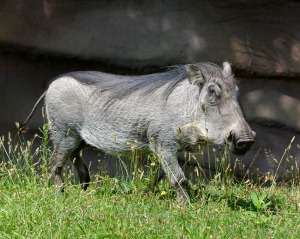Greetings from zip code 99747 in Kaktovik, Alaska!
Kaktovik lies on the far northeast coast of Alaska above the Arctic Circle and in the Arctic National Wildlife Refuge (ANWR). It is a whaling community with a long history of its people living in close proximity to polar bears. I traveled to Kaktovik in 2014 and again in 2015. This time I am fortunate to be joined by one of the Detroit Zoological Society’s (DZS) associate mammal curators, Betsie Meister, who has extensive experience with polar bears and oversees the Arctic Ring of Life, an expansive 4-acre habitat at the Detroit Zoo that is home to polar bears, seals and arctic foxes.
 We are here to help colleagues with U.S. Geological Survey, U.S. Fish and Wildlife Service and ANWR to study changes in polar bear numbers, as well as polar bear behavior and use of resources in response to the changing climate. As the climate warms, the arctic summer is getting longer and sea ice is diminishing. Polar bears come off the sea ice usually in late August and spend September and a few weeks of October in the area around Kaktovik waiting for the sea ice to form again. Polar bears use the sea ice as their platform for hunting seals, which is the majority of their wild diet. Without access to the ice, the bears are forced to spend more time on land.
We are here to help colleagues with U.S. Geological Survey, U.S. Fish and Wildlife Service and ANWR to study changes in polar bear numbers, as well as polar bear behavior and use of resources in response to the changing climate. As the climate warms, the arctic summer is getting longer and sea ice is diminishing. Polar bears come off the sea ice usually in late August and spend September and a few weeks of October in the area around Kaktovik waiting for the sea ice to form again. Polar bears use the sea ice as their platform for hunting seals, which is the majority of their wild diet. Without access to the ice, the bears are forced to spend more time on land.
 The Inupiat community of Kaktovik hunt bowhead whales every fall to store enough food for the winter. After processing the whales on the beach, the whale remains are taken about a mile and half to the edge of town and placed in the “bone pile”. Polar bears come to feast on the remains, which continue to be a strong attractant for weeks. Kaktovik, which is home to approximately 300 people year round, adds a population of polar bears numbering 15-40 and up to 80 in the late summer and fall. As a result, Kaktovik is becoming more and more popular with tourists from all over the world coming to see the polar bears.
The Inupiat community of Kaktovik hunt bowhead whales every fall to store enough food for the winter. After processing the whales on the beach, the whale remains are taken about a mile and half to the edge of town and placed in the “bone pile”. Polar bears come to feast on the remains, which continue to be a strong attractant for weeks. Kaktovik, which is home to approximately 300 people year round, adds a population of polar bears numbering 15-40 and up to 80 in the late summer and fall. As a result, Kaktovik is becoming more and more popular with tourists from all over the world coming to see the polar bears.
The bears primarily stay on the barrier islands just outside of town, but there is a great potential for human-bear conflict, and the DZS is interested in seeing how Kaktovik handles the conflict. Usually, the bears are kept away with all-terrain vehicles (ATVs) and trucks, but sometimes more force is necessary. Shotguns loaded with “cracker shells” or bean bags are then used to keep the bears away. An important safety measure that has been established is the Polar Bear Patrol. This patrol drives around Kaktovik every night from 8 p.m. to 8 a.m. protecting the community from bears wandering into town. This year, there was more whale meat at the bone pile than last year, so bears seemed to stay near the pile and away from town. Last year, while I was in Kaktovik, an incident occurred when a bear consumed some dog food from underneath the house next to ours and entered another house to feed on seal blubber.
We came to Kaktovik a week earlier than last year hoping to also observe brown bears. Brown bears have also been affected by the warming climate. They are moving farther north and coming into more contact with polar bears, overlapping more in resource use and, in some places, even hybridizing with polar bears. At Kaktovik, both bear species have been observed feeding on the whale remains, and the DZS is interested in better understanding the overlap in resource use between these species. Unfortunately, no brown bears were seen this year during our time in Kaktovik, and locals informed us that only two or three brown bears had been seen this year.
Kaktovik is just one of the communities on Alaska’s North Slope that face unique circumstances with our Earth’s changing climate. The increased interaction with polar bears and brown bears is a fascinating situation and will become increasingly important for the management of both species. With continued monitoring of bears on the North Slope, the safety of both the public and the bears will remain the top priority of the community, and the DZS will assist in this effort.
– Paul Buzzard, Ph.D., is the director of conservation for the Detroit Zoological Society and Betsie Meister is the associate curator of mammals.







